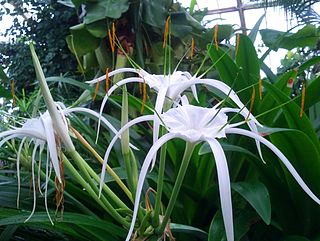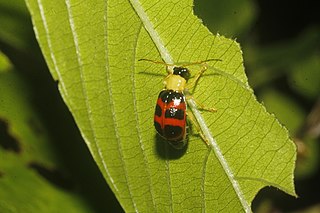
Rodolfo AmandoPhilippi was a German–Chilean paleontologist and zoologist. Philippi contributed primarily to malacology and paleontology. His grandson, Rodulfo Amando Philippi Bañados (1905-1969), was also a zoologist and in order to avoid confusion in zoological nomenclature, the elder is referred to as "Philippi [Krumwiede]" to distinguish him from his grandson "Philippi [Bañados]".

Hymenocallis (US) or (UK) is a genus of American plants in the amaryllis family.

Craugastor is a large genus of frogs in the family Craugastoridae with 126 species. Its scientific names means brittle-belly, from the Ancient Greek krauros and gastēr.
Craugastor guerreroensis, also known as the Guerreran robber frog, is a species of frog in the family Craugastoridae. It is endemic to Mexico and only known from its type locality near Agua del Obispo, in the municipality of Chilpancingo de los Bravo, Guerrero.

Tillandsia guerreroensis is a species of flowering plant in the genus Tillandsia. This species is endemic to Mexico.
Tehuana is a genus of crabs in the family Pseudothelphusidae, containing the following species:
Hymenocallis guerreroensis T.M.Howard is a bulb-forming herb native to the Mexican states of Guerrero and Morelos. Common name "Guerrero spider-lily." It is sometimes cultivated for its showy white flowers.
Johann Gustav Fischer was a German herpetologist.

Dipsadinae is a large subfamily of colubroid snakes, sometimes referred to as a family (Dipsadidae). They are found in most of the Americas, including the West Indies, and are most diverse in South America. There are more than 700 species.
Pseudorhabdosynochus guerreroensis is a diplectanid monogenean parasitic on the gills of groupers. It has been described in 2011.

The banded snail sucker is a species of snake of the family Colubridae.

Gynandrobrotica is a genus of skeletonizing leaf beetles in the family Chrysomelidae, found in the Neotropics. The genus contains at least 13 species.

Geophis annuliferus, also known as the western snail-eating snake, is a snake of the colubrid family. It is endemic to Mexico.

Geophis sartorii, also known commonly as Sartorius' snail-sucker and the terrestrial snail sucker, is a species of snake in the family Colubridae. The species is native to southern North America and Central America. There are two recognized subspecies.
Tropidodipsas fischeri, Fischer's snail-eating snake, is a species of snake in the family, Colubridae. It is found in Mexico, Guatemala, El Salvador, and Honduras.
Tropidodipsas papavericola, the poppyfield snail sucker, is a species of snake in the family, Colubridae. It is found in Mexico.
Tropidodipsas philippii, Philippi's snail-eating snake, is a species of snake in the family, Colubridae. It is found in Mexico.
Tropidodipsas repleta is a species of snake in the family, Colubridae. It is found in Mexico.
Tropidodipsas tricolor, the tricolor snail sucker, is a species of snake in the family, Colubridae. It is found in Mexico.
Tropidodipsas zweifeli, Zweifel's snail-eating snake, is a species of snake in the family, Colubridae. It is found in Mexico.








